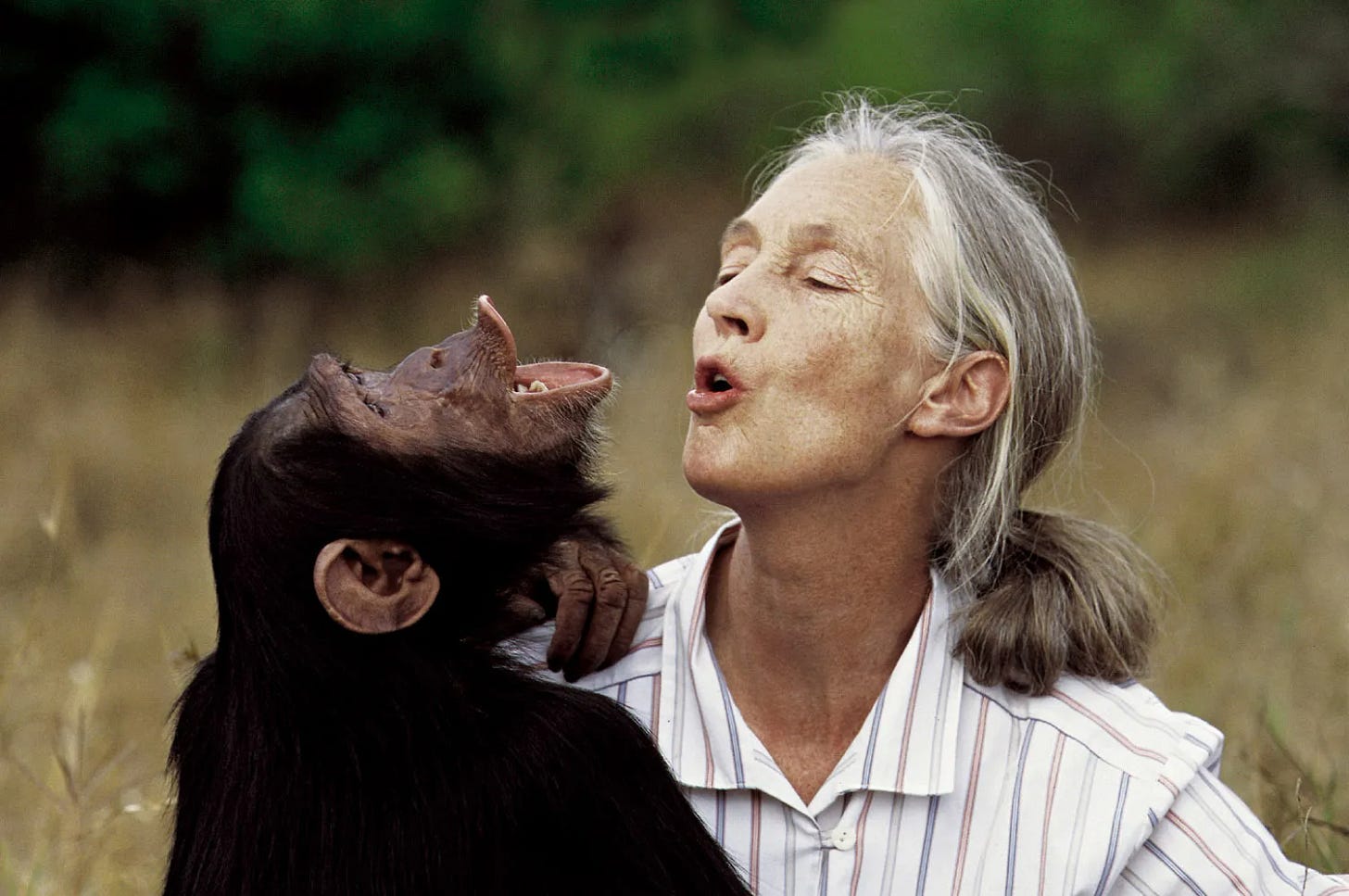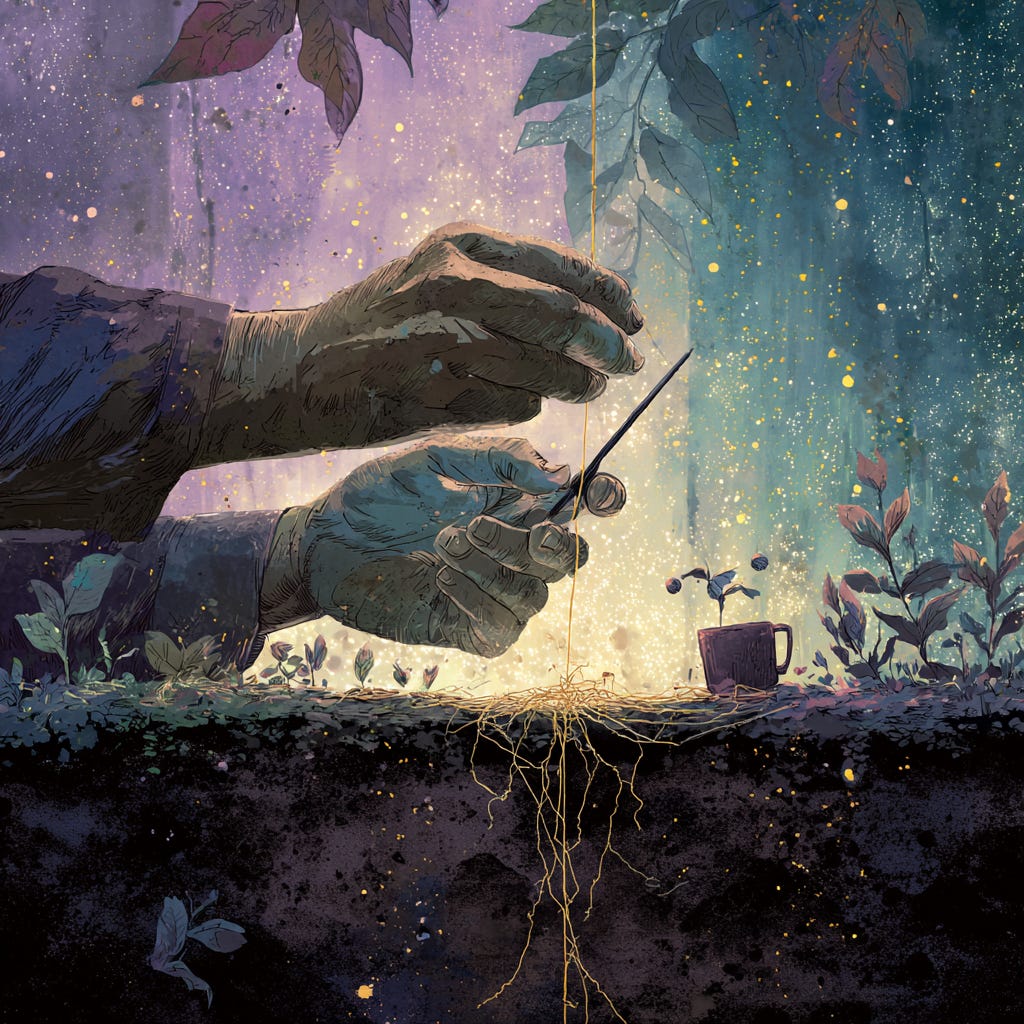Sewing the Soil
On Earth Time and Machine Time
I spent the afternoon with my aunt today. She’s en route to becoming a Master Gardener. Our conversations remind me how the garden teaches what the screen refuses: that creation moves at the pace of sap, not pixels.
This morning, kneeling with my forehead to the ground beneath me, I found myself thinking about exhaustion. Not the sharp kind that comes from physical labor, but the dull, gray fatigue of too much immediacy. My mind felt like overworked land—nothing wants to grow there right now. And maybe that’s okay. Maybe that’s the teaching.
There’s something about the phrase “sewing the soil” that keeps returning to me. I know it should be “sowing,” but the misspelling feels more true somehow. Like we’re stitching something back together. Mending what’s been torn between our creative impulse and this strange, speeding world that wants everything yesterday.
But the earth has always known better. There’s no desire to eat a green tomato, a hard avocado. Everything has its perfect ripening time, that window where the fruit gives slightly under your thumb, where the color deepens to what it was always meant to be. We’ve tried to force this process—pumping soil with synthetic fertilizers, engineering fruit that travels well but tastes like cardboard, believing we could override the seasons themselves. While caught in this acceleration, we began to believe that creativity, too, should move at the speed of upload, that inspiration should arrive on demand, just like everything else we’ve learned to summon with a click.
The word “create” shares its root with “crescere,” meaning to grow. And growth has its own intelligence about timing. Have you ever actually watched something grow? It’s almost imperceptible to our restless eyes. The pea shoots in a garden grow maybe a millimeter while you look away, making coffee, and forget to watch. This isn’t slowness, this is precision. This is the pace of real making, the underneath pace that knows exactly when each cell should divide, when each leaf should unfurl. The one we can’t Instagram.
We live in wild times. AI can generate a thousand images while I write this sentence, compose symphonies in seconds, draft novels before breakfast, Sora 2 was released this week, creating utterly realistic videos in seconds. And yet, and yet, the tomato still takes its full season to ripen. The novel that matters still needs years of living to inform it. The painting that changes someone still requires the artist to sit with emptiness first. We’re being asked to hold both: the lightning speed of silicon and the geological patience of carbon.
To live simultaneously in machine time and earth time.
Sometimes I wonder if we’ve mistaken productivity for creativity. They’re not the same creature at all. Productivity wants metrics, outputs, evidence. But creativity? Creativity wants to wander around in the dark for a while, feeling the walls, not even looking for the light switch.
I keep thinking about soil as time made visible. All those years of leaves falling, decomposing, becoming something rich enough to hold new life. Industrial agriculture tried to shortcut this, to force fertility through chemistry. But depleted soil grows depleted food. You can’t speed this up. Trust me, I’ve tried with a compost bin, impatient for black gold. The earth just laughs and keeps its own calendar.
There’s this potter I know who says clay has opinions. Strong ones. And at first I thought she was being metaphorical, but now I see how materials do have their own intelligence, their own sense of timing. Maybe the exhaustion is actually the creative soil saying: not yet, not yet, let me rest.
Robin Wall Kimmerer, author of Braiding Sweetgrass, writes about the grammar of animacy—how in Potawatomi, the living world is made of subjects, not objects. What if creativity isn’t something we do but something we’re in conversation with? And what if sometimes that conversation requires silence? Long, uncomfortable stretches of it? What if patience isn’t passive but deeply active? A radical act of resistance against the tyranny of the immediate?
I used to feel guilty about creative winters. Those fallow periods where nothing seems to happen, where the page stays empty, where the ideas feel frozen underground. But perennials spend half their lives invisible, gathering strength in root networks we can’t see. Maybe when nothing appears to be happening, everything is happening, just deeper than we’re trained to look.
The mycorrhizal networks beneath forest floors continue to teach me about creativity. How fungi connect tree roots, sharing nutrients in ways that make the idea of individual trees seem almost quaint. One tree’s excess becomes another tree’s medicine. This feels true about creative work, too. An exhausted period might be feeding something you won’t see for years. Your bright burst might be nourishing my roots in ways neither of us can track.
When I write “sewing the soil,” I mean this: taking needle and thread to the places where we’ve torn ourselves away from natural timing. Stitching ourselves back to the rhythm that knows November is for different work than July. Mending the rip between our animal bodies that understand seasons and our lit-up minds that have forgotten.
Jane Goodall understood this. For sixty years, she sat with chimpanzees, learning patience from creatures who don’t wear watches. She died this week at 91, leaving behind a language of hope that grew from the slowest kind of observation, the kind where you wait for trust to build, where you let the forest teach you its own timeline. She knew that real change happens underground first, in the dark patience of germination.

The future asks us to be bilingual. But, not in a way your AirPods can translate. Rather, to be fluent in both the instant and the eternal. To code and to compost. To upload and to wait for rain. To generate and to germinate. This isn’t about choosing sides but about developing the capacity to hold both velocities, to be citizens of both worlds.
Maybe this exhaustion isn’t a problem to be solved but a season to be honored. Maybe the dull mind is just soil being honest about its needs. Perhaps creativity isn’t about constant generation, but about learning when to lie fallow, when to be the field with nothing to show, trusting that this too is part of the process.
When we sew the soil, stitch ourselves back into the patience of growth, we remember something essential. That the best work comes from the place that refuses to be rushed, that waiting isn’t empty but full of listening. That sometimes the most creative thing we can do is nothing at all, letting the soil rest, trusting what stirs in the dark, remembering that we are not machines but creatures of season and cycle, and that our greatest power might be our capacity to hold both speeds at once: the lightning and the root, the instant and the eternal, the upload and the long, slow ripening.
Emergence with Rachel Weissman is a weekly exploration of the interconnections between consciousness, technology, and planetary flourishing.
If you find this writing valuable, leave a heart ❤️, share it with a friend, and consider subscribing if you haven’t already.



Love this idea of becoming bilingual and holding both sides of this duality between the physical and technological realms. Thank you Rachel